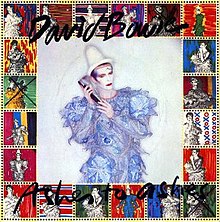
Back Ashes to Ashes (sang) Danish Ashes to Ashes (Lied) German Ashes to Ashes (canción de David Bowie) Spanish خاکستر به خاکستر (ترانه دیوید بویی) Persian Ashes to Ashes (David Bowien kappale) Finnish Ashes to Ashes (chanson) French Ashes to Ashes (David Bowie) Italian Ashes to Ashes (데이비드 보위의 노래) Korean Ashes to Ashes (David Bowie) Dutch Ashes to Ashes NN
| "Ashes to Ashes" | ||||
|---|---|---|---|---|
 One of the UK artwork variants | ||||
| Single by David Bowie | ||||
| from the album Scary Monsters (and Super Creeps) | ||||
| B-side | "Move On" | |||
| Released | 1 August 1980 | |||
| Recorded | February–April 1980 | |||
| Studio |
| |||
| Genre | ||||
| Length |
| |||
| Label | RCA | |||
| Songwriter(s) | David Bowie | |||
| Producer(s) |
| |||
| David Bowie singles chronology | ||||
| ||||
| Music video | ||||
| "Ashes to Ashes" on YouTube | ||||
"Ashes to Ashes" is a song by the English musician David Bowie from his 14th studio album, Scary Monsters (and Super Creeps) (1980). Co-produced by Bowie and Tony Visconti, it was recorded from February to April 1980 in New York and London and features guitar synthesiser played by Chuck Hammer. An art rock, art pop and new wave song led by a flanged piano riff, the lyrics act as a sequel to Bowie's 1969 hit "Space Oddity": the astronaut Major Tom has succumbed to drug addiction and floats isolated in space. Bowie partially based the lyrics on his own experiences with drug addiction throughout the 1970s.
Released as the album's lead single on 1 August 1980, "Ashes to Ashes" became Bowie's second No. 1 single on the UK singles chart and his fastest-selling single. The song's music video, co-directed by Bowie and David Mallet, was at the time the most expensive music video ever made.[1] The solarised video features Bowie as a clown, an astronaut and an asylum inmate, each representing variations on the song's theme, and four members of London's Blitz club, including the singer Steve Strange. Influential on the rising New Romantic movement, commentators have considered it one of Bowie's best videos and among the best videos of all time.
Bowie performed the song only once during 1980 but frequently during his later concert tours. Initially viewed with mixed critical reactions, later reviewers and biographers have considered it one of Bowie's finest songs, particularly praising the unique musical structure. In subsequent decades, the song has appeared on compilation albums and other artists have covered, sampled or used its musical elements for their own songs. The song's namesake was also used for the 2008 BBC series of the same name.
- ^ Buckley 2005, pp. 316–317.